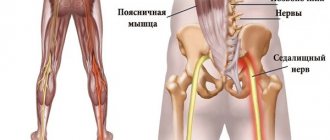To understand why hysteria initially occurs in both men and women can only be understood by delving into the physiological aspects of the problem.
Anyone who believes that a man cannot have a uterus is greatly mistaken - he does! True, the male uterus - a small cavity in the prostate that opens into the lumen of the urethra - cannot be called a full-fledged organ - it is not intended for receiving and bearing a fetus. However, the fact is irrefutable.
Actually, how do male genital organs differ from female genitals? The fact that in the process of intrauterine sexual differentiation, either the cavernous bodies of the penis or the labia are formed from the same rudiments, while the other part becomes either the prostate or the uterus.
Both of these organs are not only muscle formations, but also glandular ones. This means that they are hormonally active, largely determining the general hormonal background, creating not only the image, but also the entire philosophy of our life.
Since the need to obtain food has long ceased, and one doesn’t really want to reproduce, most of human energy has now gone into the psycho-emotional sphere - into the “production and redistribution” of the energy of emotions (for now - through “showdowns” in household, industrial and national contexts).
A man who used to carry a doe killed during a hunt into a house on his shoulders now strives to sneak out of this house, spending most of his time hunting in the wilds of the Internet, at a stadium or in a beer pub, posing as a football fan.
And the woman, who has ceased to be a reaper and washerwoman, tries hard to somehow keep this “slippery, cowardly and lazy male” next to her.
Why does she need this, clean and well-fed? The modern woman - like her primitive predecessor - is not only still filled with the fire of primitive unspent sexual power, but is also equally engulfed in the flame of unbridled passions and desires.
Only this power is still astral-emotional - it is still powerless to do at least something in this world of matter without the participation of a man. But since a man is in no hurry to voluntarily realize a woman’s many desires, she simply very skillfully “extracts” it from him.
Not by washing (whining), but by rolling (including rolling on the floor in hysterical fits on the verge of blackout).
And the uterus is “to blame” for this, having lost the meaning of life and lost its rhythm in the modern world, alien to its nature.
The uterus pulsates with a certain (variable) frequency, in a passionate desire for motherhood-pregnancy, trying to attract to itself the “beating” male prostate in one with it and extract the coveted seed from it. But, having not received what she wanted, in her righteous anger she distorts the woman’s life so much that it changes her psyche beyond recognition.
Hence the popular name for hysteria in women: uterine rabies.
But how then can we explain the man’s hysteria?
By the same mechanism: his brain and psyche, tired of “unweaving” the ingenious “lace” of female passions or struggling in their snares, put into action the male “uterus” - the prostate.
It protects its owner from female “terror” through “anti-terrorism,” powerfully activating the production of “hormones of anger, fear and despair.” Externally, the process manifests itself as a fit of male rage on the verge of rage.
Powerless rage, because what can a modest-sized male uterus do against all the power of a massive female one? And that’s why the man almost always gives in. Or runs away (including dying).
“Yes, sir, such a neurosis!”
Contrary to the generally accepted opinion that hysterical neurosis is simply a form of female bitchiness, the categorical conclusion of medical science should be cited: hysteria is one of the varieties of neurosis, because it does not have any organic substrate (if this is not the case, it is no longer hysteria).
It has long been noticed: this pathology is burdened with natures that are overly impressionable, refined, “airy”, “fluttering in the clouds” of daydreaming - and absolutely cut off from sinful earthly life with all its dirt and mold.
Raised with copious tears and sighs from novels and movies, these “muslin young ladies” are simply unable to endure the touch of rough, materially dense life, the slightest breath of it simply knocks them off their feet - there is no need to talk about direct coercion and violence at all.
For these are, for the most part, individuals raised under the gaze of a whole series of generations of similarly educated women - mothers and grandmothers - who are ready to run for a thermometer or an enema at the slightest change in the “princess’s” facial features.
Accustomed to their own, “innate” weakness, “sickness” and helplessness, living with an eye on who to lean on (more precisely, who to hang on), people of this type never live their own lives - their heads are full of other people’s, operetta-like ideas about what as it should be ideally.
And these ideas are so strong and resourcefully tenacious that the hysteric becomes a real despot, imposing them on everyone around him - whoever dares to offend a fragile “porcelain doll”, it is better to give in. As a person grows up, she gets used to believing that it simply cannot be any other way.
And this fragile butterfly (and a tenacious leech rolled into one) is brought into life, where you have to somehow act and say something. What to do if your legs can’t hold you up?
Yes, just falling into the arms of the first suitable compassionate representative of the opposite sex - your head is spinning, they say! She was really dizzy, and for good reason.
After all, these naive dreamers never have any idea of their own about specific everyday affairs - the “drive belts” of life; they are worried and frightened even by the very prospect of having them. Their credo is “yes, but...”. And this, said in a weak voice in which tears tremble, “but” categorically excludes the possibility for them to do anything on their own.
Having fallen into someone else's heartily open arms, hysterical people remain in them for the rest of their lives - they are “too weak” to walk on their own feet.
Having settled comfortably in a quiet, “windless” place, a fragile butterfly can bring offspring - and after that don’t say a word to it at all: I am for you, not sparing myself, and you...! Or something similar. But this comfort is purely external, because in the head of such a cut personality there is real soda.
general characteristics
Childhood hysteria (hysterical neurosis) is a state of extreme nervous excitement, accompanied by loss of self-control and inappropriate behavior. From the outside it looks ugly and scares everyone around. Most often used consciously to achieve what you want. However, there are exceptions to this rule. Attacks can be dictated by psychological trauma or diseases of the nervous system. In such cases, the help of neurologists and psychotherapists is required.
Despite the fact that most parents know how to stop children's tantrums (ignore them), not everyone succeeds. Sometimes adults take this advice too literally and do not carry out any work at all with a child prone to such attacks. In fact, ignoring is only used in the midst of a seizure. And before and after it, it is necessary to use the techniques and techniques offered by psychologists and psychotherapists.
What's going on inside the hysterical person?
It is impossible to say that those suffering from hysteria are absolutely and serenely happy. For this is a constant state of intense anticipation of some kind of trouble, tragedy and cataclysm of any scale, which is extremely exhausting for them personally and for everyone around them. The psyche of the sufferer (or sufferer) is full of fears and all sorts of obsessive thoughts that cannot be escaped.
The essence of this personality type is eternal panic when thinking not even about tomorrow, but about the day that has already arrived and the current one, in which something can happen. And if (suddenly!) nothing happens, so much the worse; an accomplished drama is better than foggy uncertainty. “Drama” can mean anything from missing hair clips to an alleged Martian invasion.
An attempt to work or serve for those suffering from hysteria ends disastrously: eternal stay “on sick leave” makes the employee undesirable to the enterprise and leads to dismissal. Which further strengthens the belief in one’s absolutely exceptional morbidity and absolute helplessness.
Illnesses are generally a separate “playing field” for the hysterical. The tense anticipation of troubles cannot but lead to some changes in health, and now it has happened! - the illness struck. A thorough analysis of it and comparison with what is “in the medical reference book” instantly leads to the conclusion about a serious or even incurable disease.
And if there is also a truly sick person in the family or someone has recently died... For the hysterical, the only possible conclusion arises: of course, I will be next (next).
Diseases. The indispensable and heaviest “brick in the wall”, which fences off the hysterical person from the world.
But about the extreme manifestations of hysteria, special mention should be made.
Age characteristics
The most striking hysterics occur at 2-3 years, when the child is still learning to behave, assimilates behavioral norms, tries to assert himself and become independent. However, it is at this age that, with the correct attitude of adults, they quickly stop and do not return (only in extreme cases, under the influence of severe stress). It is much more difficult to cope if they appear later.
2 years
The age when the first real hysterics begin. If before the baby could simply cry, now he does it with defiance and trying to identify the problem. Therefore, it usually all starts with the words: “give, let, buy, want, leave, I won’t...”. He already understands the meaning of the words “no” and “impossible” and tries to protest against them. The speech apparatus is still too poorly developed, so the persuasive power of the word is not available, and with such attacks he tries to convey his desires to adults.
Parents are strictly prohibited from:
- rush to immediately satisfy all his demands, just to stop the hysteria - he will grow up capricious and spoiled;
- screaming and hitting - fear will appear, complexes will develop, or, even worse, physical violence will lead to psychological trauma.
You need to hug the baby, show him your love that you are nearby, ask him to calm down, or simply distract his attention. Usually, such techniques work at 2 years of age. If it doesn’t work, start ignoring it. Next, indicate your dissatisfaction and say that this cannot be done. As a rule, after 5-6 hysterics, when their uselessness is realized, everything ends.
Parents should be wary if, even after all this work, their two-year-old child is constantly hysterical. Most likely, these are no longer just whims, but something psychosomatic. Perhaps he is overtired or feels some kind of discomfort. Review your daily routine and nutrition. Maybe this is how the stress on the kindergarten is expressed. If necessary, undergo a medical examination.
3 years
In psychology there is the concept of “three-year crisis.” The clash of interests between “fathers and sons” is reaching its peak. It seems to him that he is already an adult, he can do everything himself. But he constantly comes across a system of restrictions (you can’t have a lot of ice cream, you can’t sit for a long time at a tablet, you can’t walk through puddles) and the desire of your parents to help with everything (tie your shoelaces, get dressed, make the bed, pour tea). A pronounced protest against all these rules and guardianship begins. Even previously obedient children begin to throw tantrums. Age-related features of attacks:
- The reason can be absolutely any, even the most insignificant situation (mom straightened her shirt collar);
- often parents don’t even understand why it all started;
- up to 10 attacks occur per day;
- the most striking, frightening manifestations of adults.
Parents must understand that a 3-year-old child should have partial independence and the right to choose in some situations (which toy to go to bed with, which shorts to wear). If he hears several times a day how independent and mature he is, he will no longer need to assert himself. The blip in the subconscious will be eliminated - and the hysterics will stop.
4 years
At this age, whims become more conscious and purposeful. In most cases, they are dictated by an incorrect education system. Children 4 years old are smart and observant. Does your mother forbid you to do something? Then you need to achieve this from your grandmother, who will allow her beloved grandson everything, as long as he does not bang his head against the wall. In such cases, it is necessary for all relatives to gather and once again discuss the lists of permitted and taboo items.
Sometimes it happens that a child usually behaves well, understands prohibitions and the word “no”, does not go beyond what is permitted, but from time to time he still throws tantrums for the most insignificant reasons (sometimes even without them). At the same time, he himself cannot clearly formulate his requirements. In most cases, this indicates psychosomatic disorders that require the intervention of a neurologist.
If the disease is not identified, the cause must be sought in relationships with adults. Perhaps he has a conflict with his stepfather or teacher. Family problems cannot be discounted: divorce, constant quarrels between parents, etc. Psychotrauma often manifests itself through hysteria. In these cases, it is necessary to make an appointment with a psychotherapist.
5-6 years
At 5 years old, according to psychologists, the second age crisis occurs. Not as powerful as at 3 years old, but sometimes manifested quite clearly. It is characterized by:
- isolation (stops sharing secrets, increasingly wants to be alone, locks himself in his room);
- self-doubt, fears, phobias, panic attacks;
- mood swings, the appearance of irritability, sudden attacks of aggression and anger (most often causeless);
- tearfulness;
- blindly copying parents, simulating life situations;
- standing up for your rights.
All these factors can become fertile ground for hysteria. Sometimes literally little things are enough to cause an attack. Maybe someone came into the room when they wanted to be alone. Or he behaved like his parents (said a bad word), and he was punished for it. Often ordinary tears develop into a seizure.
According to psychologists, tantrums at 5 years old are in most cases dictated by a lack of parental love and attention. Look at your family from the outside: do you spend all day at work, do you have dinners together, how often do you go out together? To prevent this from happening again, it’s enough to carve out time for your child in your busy schedule.
As for the attacks themselves, self-harm can no longer be left unattended, as in 2-4 years, because it can result in serious injuries. It is urgent to pick up the child from the floor, move him away from the wall, holding him tightly by the hands, and take him somewhere quiet. At the same time, there is no need to babysit (he is already big enough for this) and try to explain something. Wait until he calms down and then have a conversation.
Psychologists advise that if you have constant hysterics at the age of 5-6 years, make an appointment with a psychotherapist.
7 years
Tantrums at 7 years old are most often situational in nature. The first situation that provokes an attack is the need to attend school. The child is faced with a bunch of rules, requirements and restrictions: he has to do his homework, sit still for 40 minutes, follow the bell schedule, listen to the teachers. At the same time, your social circle changes, classmates, new acquaintances, and friends appear. The causes of hysteria are usually:
- basic fatigue;
- emotional stress;
- the authoritarian nature of the teacher’s teaching, if the parents raised the child at home in a calm and gentle manner;
- uncomfortable environment and poor discipline in the classroom, when everyone around is screaming and fighting;
- blindly copying one of your classmates if he threw a tantrum at school.
In this case, you just need to talk with the teacher and school psychologist. They will help resolve the current situation. If the tantrums continue and you are sure that the school is to blame, you should think about changing it.
The second situation that provokes an attack is the family situation. By this time, relations between parents may deteriorate (no one has canceled family crises), or another child appears, or someone dies. The causes of hysteria are:
- open conflicts between parents, quarrels in a raised voice;
- drunkenness, assault, fights;
- jealousy of the younger child, lack of attention and love;
- psychotrauma due to the death of someone close.
In this case, it is strongly recommended to make an appointment with a family therapist.
8-9 years
If hysterics began at such a late age, this is an alarming signal. He has already formed attitudes and rules of behavior: what is possible and what is not. Surely he will not demand a toy in the store in this way. Adaptation to school also ends by this period. The reason most often becomes some kind of psychotraumatic situation: conflict with peers, problems in mastering a subject, nervous breakdown, exhaustion, injustice.
At 8-9 years old, a child already knows how to control his emotions, so experts in such cases abandon the term “hysteria” and talk about a clinical diagnosis - hysterical neurosis. If attacks occur more than 2 times in a short period of time, you must immediately go to a psychotherapist or neurologist.
Soon, soon will the gravestone hide my chest?
A woman who always wants to be the one and only, but experiences terrible inner uncertainty in this world of gross matter, tries to attract the attention of a male support through hysterical behavior in the form of theatricality and affectation, excessively loud laughter, ridiculous haircut and hair color, inventing himself with various fables and other ostentatious antics.
But when these techniques do not work, the last trump card is used in the form of a hysterical attack.
With all her appearance, the woman screams: here I am, and I desperately need help!!! She screams literally, piercingly loud.
It screams so that the face turns purple and the veins on the head swell, and the mouth becomes distorted, while the body makes the most wild and unbridled movements, no longer subject to the will of the mistress: it falls to the floor, rolls around on it, arching, beating with its legs and arms, scratching its face and pulls out hair.
For the consciousness of the owner of the body is darkened - it is not here now, but in the twilight zone, and only pain or a bucket of ice water dousing the body can bring it back from there.
Hysteria in women is most often accompanied by imitation of disorders of the central nervous system, the symptoms of which appear:
- neurogenic blindness, deafness, vomiting, suffocation (simulating an asthmatic attack);
- pain in the heart (like angina);
- pseudoparalysis and pseudoparesis.
Everything is “pseudo”, because with the end of the seizure, body functions are completely restored. But memories of what recently happened to the body and consciousness are not preserved.
Not only lonely, sexually unsatisfied women, but also completely legitimate husbands and wives can suffer from hysterical attacks.
A physiological (due to excess estrogen in the blood) reason for a seizure may be:
- long-term sexual abstinence;
- a certain phase of the menstrual cycle;
- pregnancy;
- menopause;
- chronic alcohol or drug intoxication;
- overstrain of the brain and body, languishing from idleness;
- excess coffee “got to the head” or the consequences of a very specific cranial injury;
- stress both in the family and at work.
The problems are not just yesterday, but have been accumulating for years. And now, finally, they have found a way out in such desperately uncontrollable, often public behavior, which brings colossal relief.
A relief that will soon require repeating. This means that a continuation is coming “in the next episode.” Or depression and even a suicide attempt from the realization of what has been done (for not all religions and cultures allow such “unbridled” behavior). And the very movements of a body uncontrolled by the mind can lead to its death, just like during an epileptic seizure.
This is the answer to the question: what is the danger of hysteria specifically for the body (for the manipulation of the consciousness of family members in this case is obvious and does not need comment).
In addition, there is a direct threat to the psyche of a patient with hysteria - he sinks more and more into the swamp of self-pity and the search for more and more new diseases and symptoms, dooming himself to increasingly desperate loneliness in the circle of those who previously loved him and who judge him and treat him with irritation and anger .
Causes
The main reason for hysteria is a clash of interests between the child and parents. With age, he develops personal preferences and desires that diverge from the requirements of adults. If you fail to achieve your goal, hysteria begins. There are several typical situations that provoke this condition. They can be caused by psychological and physiological factors.
Psychological on the part of the child:
- lack of opportunity to verbally express dissatisfaction (when one cannot yet speak);
- attracting attention that is not enough;
- an irresistible desire to achieve something;
- expression of protest;
- stubbornness;
- imitation of peers or adults;
- psychotrauma;
- weak, unbalanced type of nervous system.
Psychological from adults (parents, relatives, educators, teachers):
- overprotection, excessive severity;
- incorrect system of punishments and rewards or its absence;
- interruption of a favorite activity;
- violation of personal space;
- mistakes in education.
Physiological:
- lack of sleep;
- overwork, excessive physical or emotional stress;
- hunger;
- diseases of the nervous system;
- illness or rehabilitation period after illness.
To wean a child from hysterics, you must first understand the reasons that drive him. If these are ordinary whims (I want this, buy that), you can deal with them quickly and easily. If the education system is to blame, it needs to be reviewed and radically changed, otherwise there will be no progress. It will be much more difficult and longer to work if psychosomatics or health problems are to blame. In this case, a course of treatment from a neurologist or psychotherapist is inevitable.
Entrance is open, and not only for women
Not only women, but also men and children unconsciously resort to hysteria as a way to almost instantly get rid of accumulated mental ballast.
But if a child’s hysteria has one meaning: finally notice me - and love me for who I am - then in men it is different and means: leave me alone!
Both categories can respond to mental pressure with sleep and appetite disorders, headaches and loss of strength.
A very young child often wakes up at night with hysterics, falls to the floor crying, knocking his legs and arms, hitting his head on the floor.
But in men, hysteria also has the following symptoms:
- sexual weakness or impotence;
- pseudocardiac and pseudogastric pain;
- causeless suffocation and suppression;
- paleness (redness) of the face with sweat on the skin;
- tremors in the hands, tics and other neurotic manifestations of stress.
Eloquently saying: you “got me”! “Pseudo” means that all changes occurring in the body pass without a trace along with the disappearance of reasons for psychological stress.
Is hysteria real or fake?
Hysteroepilepsia, or the debut of an epileptic disease with hysterical seizures, is otherwise called imitation hysteria and is often classified as a neurosis of childhood in children with epilepsy, complicating diagnosis and delaying treatment of the true cause of hysterical reactions.
Hysterical manifestations with imitation of seizures and true epilepsy occurring in adults are frequent.
What is the difference between a hysterical and epileptic seizure?
This:
- the absence in a hysterical seizure of a clearly defined clonic and tonic stage typical of an epileptic one;
- emphasized unconscious posing with pretentious movements and facial expressions (with particular agitation in crowded places) and preservation of pain and pupillary reactions during hysteria;
- a neurological “trail” often remaining after a hysterical attack in the form of spastic and flaccid paralysis, paresis, contractures, aphonia, manifestations of astasia-abasia, as well as anuria (or polyuria), belching, hiccups, tachycardia, which is unusual for an epileptic seizure;
- completion of an epileptic seizure with sleep or bodily-motor agitation, oligophasia (absent during a hysterical attack).
However, “unraveling the tangled braid” from a combination of epileptic and hysterical symptoms can be extremely difficult. And here instrumental diagnostics in the form of an EEG come to the rescue, making it possible to detect both changes in electrical activity unusual for hysteria, and the epileptogenic foci themselves.
Sedation and “lying down”, or the treatment of seizures
Treatment of hysteria and hysterical neurosis should be comprehensive and include the use of psychotropic drugs, psychotherapy, restoratives, and physical therapy methods; Spa treatment courses are useful.
With the development of neurotic states, especially those accompanied by affective (including depressive) disorders that cannot be treated on an outpatient basis, “lying down” is indicated - hospitalization in the department of a psychiatric hospital for “calm neurotics”.
The arsenal of drug therapy for hysteria includes the use of tranquilizers, the best effect of which is obtained by dosed, hourly use per os:
- Diazepam – Seduxen, Oxazepam – Tazepam, Chlordiazepoxide – Elenium from 10 to 30 mg/day;
- Phenazepam from 1 to 3 mg/day;
- Meprotane – Meprobamate from 200 to 800 mg/day.
What to do in case of massive hysteria?
In case of persistent obsessions, massive hysterical disorders, intramuscular and, in case of inpatient care, intravenous drip administration of tranquilizers (Diazepam, Chlordiazepoxide) or connection to therapy with small doses of antipsychotics are justified:
- Etaperazine from 4 to 12 mg/day;
- Chlorprothixene from 15 to 50 mg/day;
- Thioridazine – Melleril from 10 to 50 mg/day;
- Neuleptil – Propericiazine from 10 to 20 mg/day.
Or the use of drugs with a prolonged period of action - Fluorophenazine-decanoate (Moditen-depot) from 12.5 to 25 mg 1 time/2 weeks.
Patients with predominant manifestations of asthenia are effectively treated with a combination of tranquilizer-Piracetam (Nootropil) or tranquilizer-Aminalon.
The severity of affective (depressive) disorders requires a combination of a tranquilizer and antidepressant (Amitriptyline with Chlordiazepoxide and the like).
Cases with persistent sleep disturbance are treated with Nitrazepam (Eunoctin, Radedorm) from 5 to 15 mg, Phenazepam from 0.5 to 1.5 mg, Teralen from 5 to 10 mg, Chlorprothixene 15 mg.
What to do if a 2-3 year old child is hysterical - advice from a psychologist:
Dr. Komarovsky has his own view on children's hysteria:
When to see a specialist
Parents do not always successfully cope with children's tantrums, even if they do everything right. This occurs in cases where attacks are dictated by persistent disturbances in the functioning of the nervous system or psychological trauma. They require the mandatory intervention of specialized specialists - a psychotherapist or neurologist. What signals indicate the need for such a step? If hysterics:
- continue despite all the measures taken by adults, which turn out to be ineffective;
- arranged daily;
- characterized by excessive, uncontrolled aggression, directed at everyone indiscriminately who happens to be nearby;
- accompanied by loss of consciousness, respiratory arrest, shortness of breath, vomiting;
- get a job after 4 years;
- last more than 20 minutes;
- occur at night, accompanied by nightmares and panic attacks;
- end in serious injury and damage to oneself and others.
Night hysterics are considered especially dangerous, requiring immediate intervention from a specialist. Parents should also be wary if, after the attack ends, the child remains in a state of complete apathy for some time, lies down, does not react to anything, is pale and lethargic. This can last 1.5 hours or more.
How to prevent the development of hysteria
First of all, it is necessary to shift the emphasis in life from the patient’s ego, which is painfully inflated by excessive attention, to other, no less important aspects of existence. It is necessary that the child being raised is as open to the world as possible and finds his rightful place in it, and does not languish in anxious loneliness on a “pedestal” that is inaccessible in height for him to be able to jump onto it.
Any suggestion of exclusivity, pain, or helplessness should be excluded from verbal communication and the customs and traditions of the family. It should be taken into account that this process is not quick, often requiring the re-education of several generations of the parents themselves.
When preparing a child for independent life, it is worth resolving the issue of rational professional guidance with the possibility of eliminating occupational hazards in the form of additional neuroticization of the individual at work.
Everything must be done so that the individual can believe that he is capable of life without the care of parents and patrons.
And for this, she needs to be unobtrusively but demandingly encouraged to take the first few independent steps as early as possible. For any journey begins with standing on your own feet. And, as Tsiolkovsky once aptly said on another occasion, “you can’t live forever in a cradle.”











